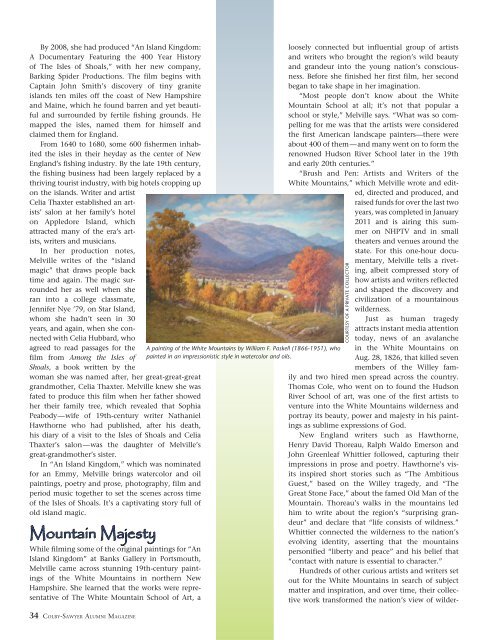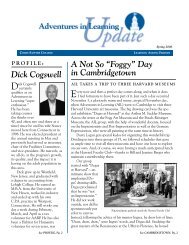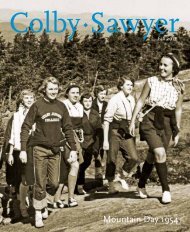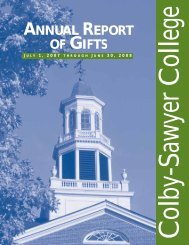A L U M N I M A G A Z I N E - Colby-Sawyer College
A L U M N I M A G A Z I N E - Colby-Sawyer College
A L U M N I M A G A Z I N E - Colby-Sawyer College
You also want an ePaper? Increase the reach of your titles
YUMPU automatically turns print PDFs into web optimized ePapers that Google loves.
By 2008, she had produced “An Island Kingdom:<br />
A Documentary Featuring the 400 Year History<br />
of The Isles of Shoals,” with her new company,<br />
Barking Spider Productions. The film begins with<br />
Captain John Smith’s discovery of tiny granite<br />
islands ten miles off the coast of New Hampshire<br />
and Maine, which he found barren and yet beautiful<br />
and surrounded by fertile fishing grounds. He<br />
mapped the isles, named them for himself and<br />
claimed them for England.<br />
From 1640 to 1680, some 600 fishermen inhabited<br />
the isles in their heyday as the center of New<br />
England’s fishing industry. By the late 19th century,<br />
the fishing business had been largely replaced by a<br />
thriving tourist industry, with big hotels cropping up<br />
on the islands. Writer and artist<br />
Celia Thaxter established an artists’<br />
salon at her family’s hotel<br />
on Appledore Island, which<br />
attracted many of the era’s artists,<br />
writers and musicians.<br />
In her production notes,<br />
Melville writes of the “island<br />
magic” that draws people back<br />
time and again. The magic surrounded<br />
her as well when she<br />
ran into a college classmate,<br />
Jennifer Nye ’79, on Star Island,<br />
whom she hadn’t seen in 30<br />
years, and again, when she connected<br />
with Celia Hubbard, who<br />
agreed to read passages for the<br />
film from Among the Isles of<br />
Shoals, a book written by the<br />
woman she was named after, her great-great-great<br />
grandmother, Celia Thaxter. Melville knew she was<br />
fated to produce this film when her father showed<br />
her their family tree, which revealed that Sophia<br />
Peabody—wife of 19th-century writer Nathaniel<br />
Hawthorne who had published, after his death,<br />
his diary of a visit to the Isles of Shoals and Celia<br />
Thaxter’s salon—was the daughter of Melville’s<br />
great-grandmother’s sister.<br />
In “An Island Kingdom,” which was nominated<br />
for an Emmy, Melville brings watercolor and oil<br />
paintings, poetry and prose, photography, film and<br />
period music together to set the scenes across time<br />
of the Isles of Shoals. It’s a captivating story full of<br />
old island magic.<br />
Mountain Majesty<br />
While filming some of the original paintings for “An<br />
Island Kingdom” at Banks Gallery in Portsmouth,<br />
Melville came across stunning 19th-century paintings<br />
of the White Mountains in northern New<br />
Hampshire. She learned that the works were representative<br />
of The White Mountain School of Art, a<br />
34 COLBY-SAWYER ALUMNI MAGAZINE<br />
loosely connected but influential group of artists<br />
and writers who brought the region’s wild beauty<br />
and grandeur into the young nation’s consciousness.<br />
Before she finished her first film, her second<br />
began to take shape in her imagination.<br />
“Most people don’t know about the White<br />
Mountain School at all; it’s not that popular a<br />
school or style,” Melville says. “What was so compelling<br />
for me was that the artists were considered<br />
the first American landscape painters—there were<br />
about 400 of them—and many went on to form the<br />
renowned Hudson River School later in the 19th<br />
and early 20th centuries.”<br />
“Brush and Pen: Artists and Writers of the<br />
White Mountains,” which Melville wrote and edited,<br />
directed and produced, and<br />
raised funds for over the last two<br />
years, was completed in January<br />
2011 and is airing this summer<br />
on NHPTV and in small<br />
theaters and venues around the<br />
state. For this one-hour documentary,<br />
Melville tells a riveting,<br />
albeit compressed story of<br />
how artists and writers reflected<br />
and shaped the discovery and<br />
civilization of a mountainous<br />
wilderness.<br />
Just as human tragedy<br />
attracts instant media attention<br />
today, news of an avalanche<br />
A painting of the White Mountains by William F. Paskell (1866-1951), who in the White Mountains on<br />
painted in an impressionistic style in watercolor and oils.<br />
Aug. 28, 1826, that killed seven<br />
members of the Willey family<br />
and two hired men spread across the country.<br />
Thomas Cole, who went on to found the Hudson<br />
River School of art, was one of the first artists to<br />
venture into the White Mountains wilderness and<br />
portray its beauty, power and majesty in his paintings<br />
as sublime expressions of God.<br />
New England writers such as Hawthorne,<br />
Henry David Thoreau, Ralph Waldo Emerson and<br />
John Greenleaf Whittier followed, capturing their<br />
impressions in prose and poetry. Hawthorne’s visits<br />
inspired short stories such as “The Ambitious<br />
Guest,” based on the Willey tragedy, and “The<br />
Great Stone Face,” about the famed Old Man of the<br />
Mountain. Thoreau’s walks in the mountains led<br />
him to write about the region’s “surprising grandeur”<br />
and declare that “life consists of wildness.”<br />
Whittier connected the wilderness to the nation’s<br />
evolving identity, asserting that the mountains<br />
personified “liberty and peace” and his belief that<br />
“contact with nature is essential to character.”<br />
Hundreds of other curious artists and writers set<br />
out for the White Mountains in search of subject<br />
matter and inspiration, and over time, their collective<br />
work transformed the nation’s view of wilder-<br />
COURTESY OF A PRIVATE COLLECTOR









